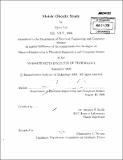| dc.contributor.advisor | Stephen S. Intille. | en_US |
| dc.contributor.author | Lee, Hyon (Hyon I.) | en_US |
| dc.contributor.other | Massachusetts Institute of Technology. Dept. of Electrical Engineering and Computer Science. | en_US |
| dc.date.accessioned | 2011-02-23T15:02:02Z | |
| dc.date.available | 2011-02-23T15:02:02Z | |
| dc.date.copyright | 2009 | en_US |
| dc.date.issued | 2009 | en_US |
| dc.identifier.uri | http://hdl.handle.net/1721.1/61305 | |
| dc.description | Thesis (M. Eng.)--Massachusetts Institute of Technology, Dept. of Electrical Engineering and Computer Science, 2009. | en_US |
| dc.description | Cataloged from PDF version of thesis. | en_US |
| dc.description | Includes bibliographical references (p. 63-65). | en_US |
| dc.description.abstract | The prevalence of overweight and obesity has steadily increased over the years among all genders, ages, racial and ethnic groups, educational levels, and smoking levels [15]. From 1960 to 2004, the prevalence of overweight increased from 44.8 to 66 percent in U.S. adults age 20 to 74 [14]. The prevalence of obesity during this same time period more than doubled among adults age 20 to 74 from 13.3 to 32.1 percent, with most of this rise occurring since 1980 [14]. As these numbers increase, more people are prone to diabetes and increased risk for congestive heart disease, high blood pressure, osteoarthritis, dyslipoproteinemia, various cancers, and all-cause mortality [5]. With two thirds of American adults of age 20 or older being overweight or obese [13], it is imperative to prevent these numbers from rising any further; and, one way is to increase the level of general physical activity [5]. The main idea of the study is to use a mobile device (in our case, a mobile phone) to automatically and continuously monitor physical activity and then to reinforce increases in physical activity using positive reinforcement and operant conditioning learning theory. Prior work in behavioral science suggests that well-timed, positive, and tailored messages can influence behavior. This will be the first study to investigate the potential of using automatic activity recognition using sensors to apply this theory and to measure the impact consistent application of the theory might have on motivating behavior changes. Although we will study physical activity, the same strategies could be used to encourage other desired behavior changes. | en_US |
| dc.description.statementofresponsibility | by Hyon Lee. | en_US |
| dc.format.extent | 65 p. | en_US |
| dc.language.iso | eng | en_US |
| dc.publisher | Massachusetts Institute of Technology | en_US |
| dc.rights | M.I.T. theses are protected by
copyright. They may be viewed from this source for any purpose, but
reproduction or distribution in any format is prohibited without written
permission. See provided URL for inquiries about permission. | en_US |
| dc.rights.uri | http://dspace.mit.edu/handle/1721.1/7582 | en_US |
| dc.subject | Electrical Engineering and Computer Science. | en_US |
| dc.title | Mobile obesity study | en_US |
| dc.title.alternative | Mobile health | en_US |
| dc.type | Thesis | en_US |
| dc.description.degree | M.Eng. | en_US |
| dc.contributor.department | Massachusetts Institute of Technology. Department of Electrical Engineering and Computer Science | |
| dc.identifier.oclc | 702660965 | en_US |
